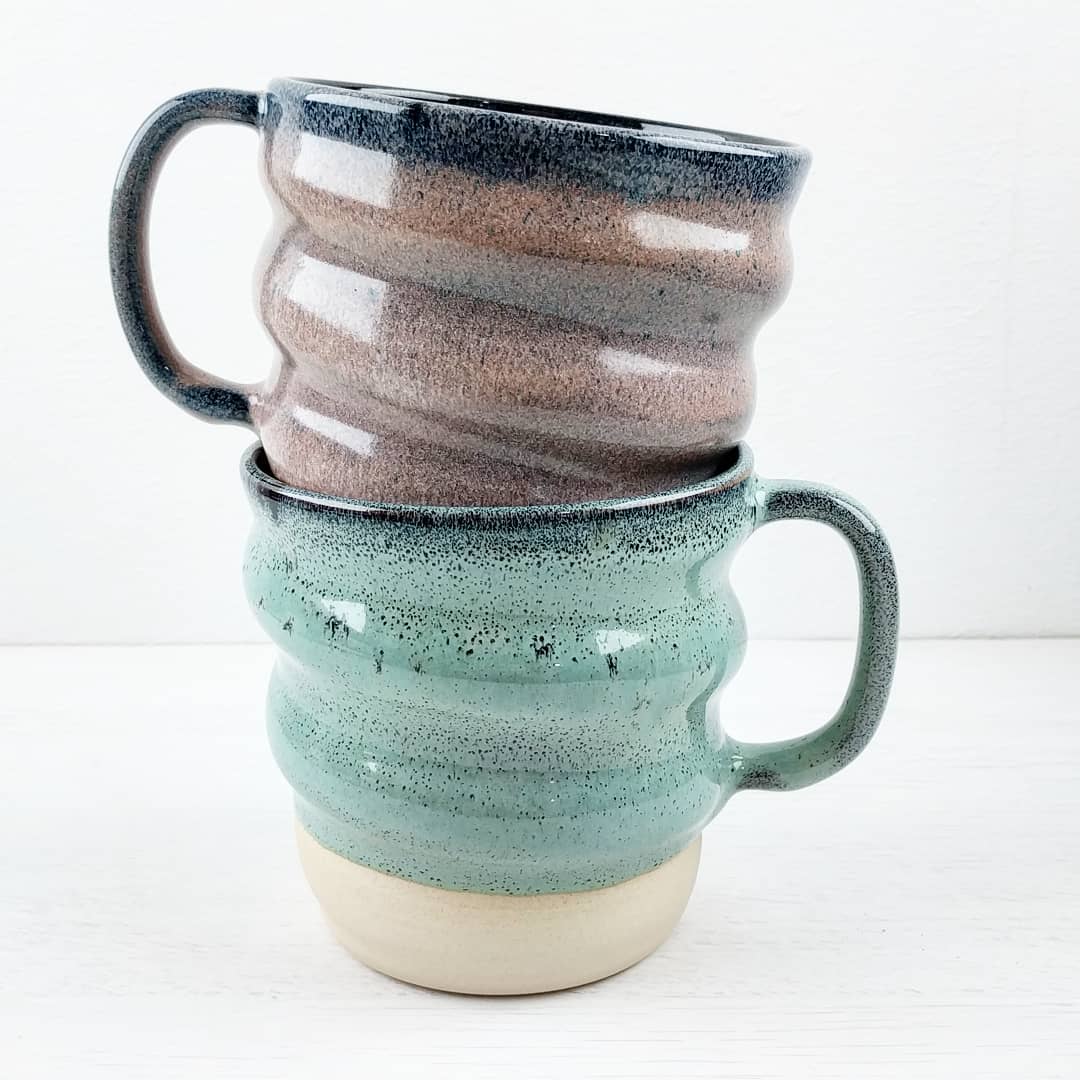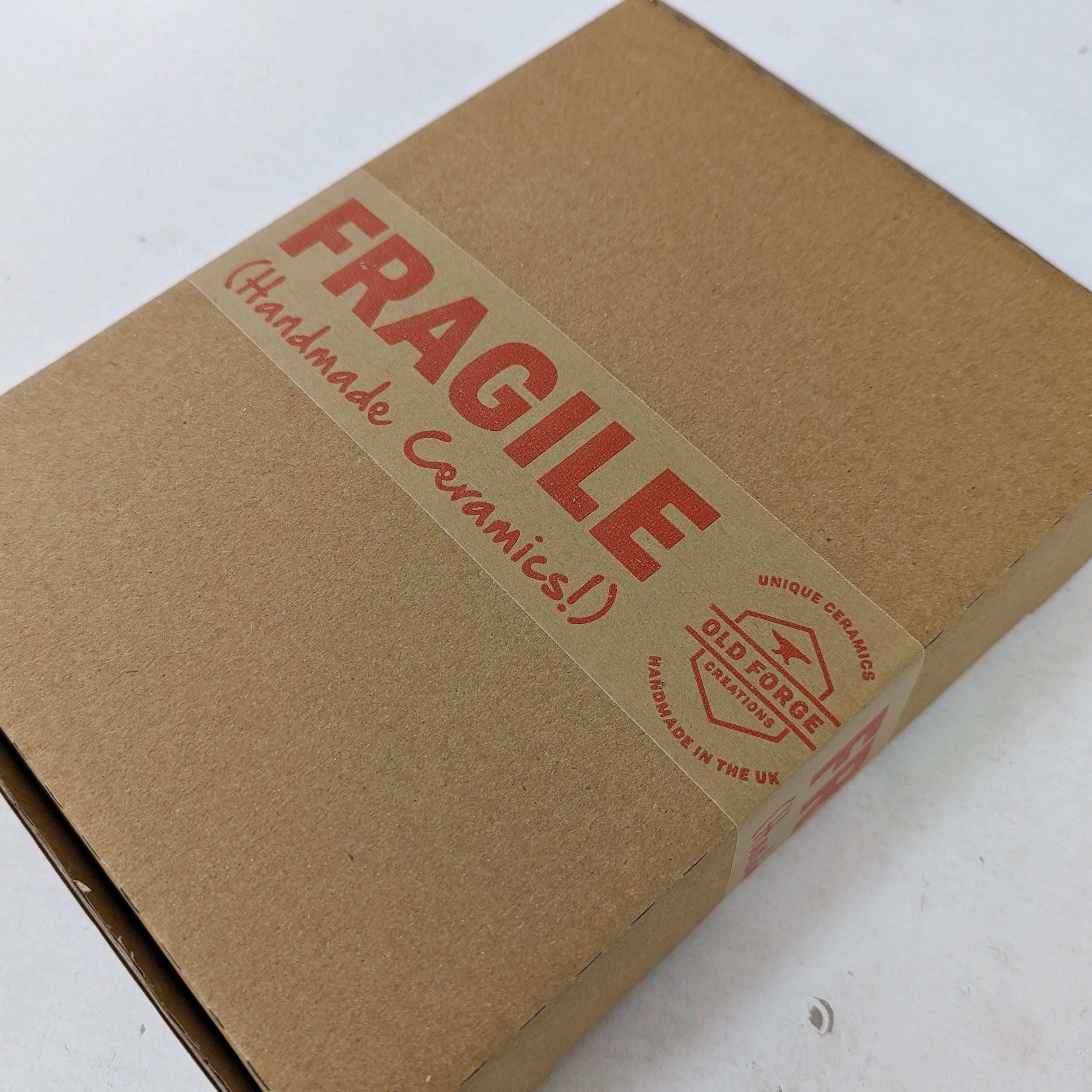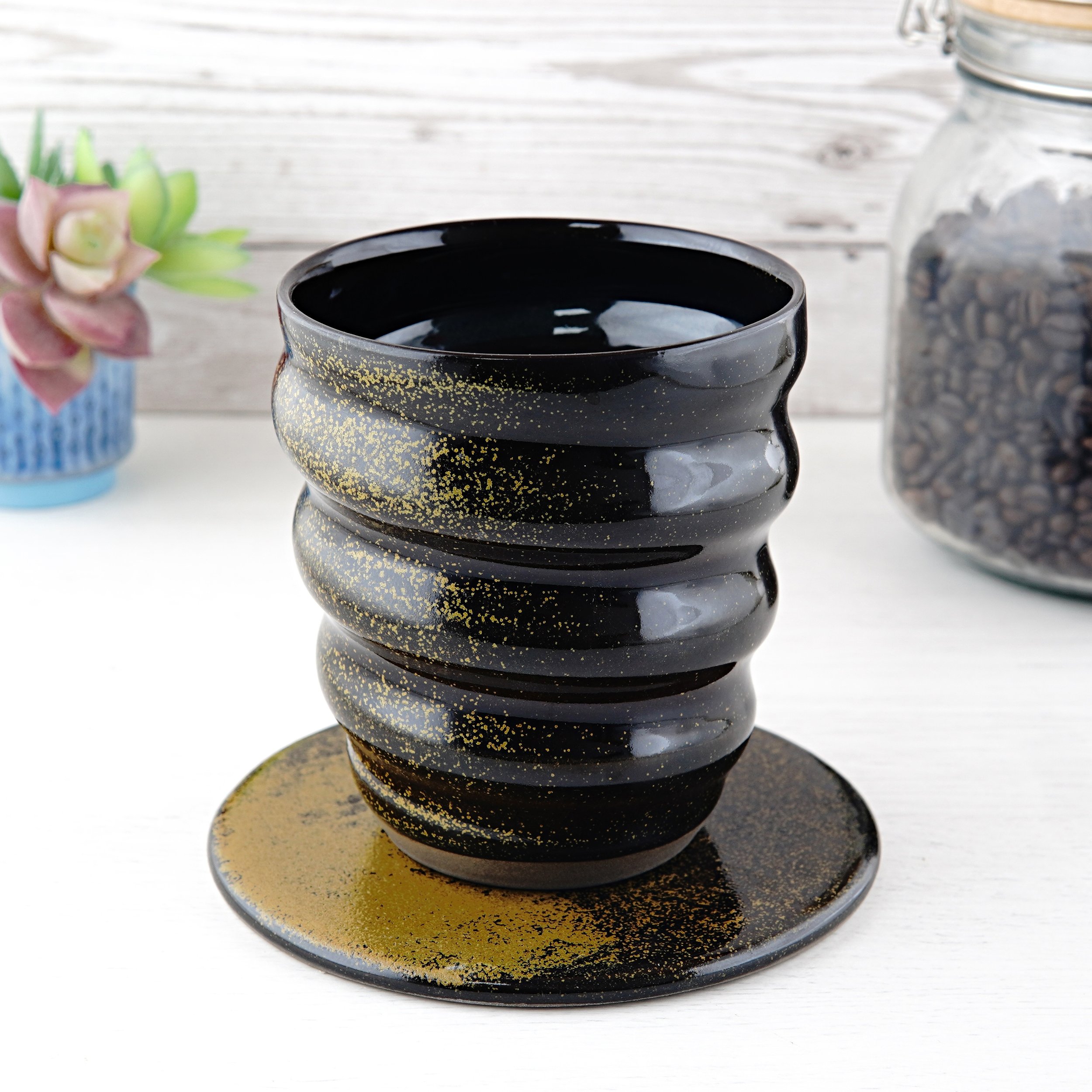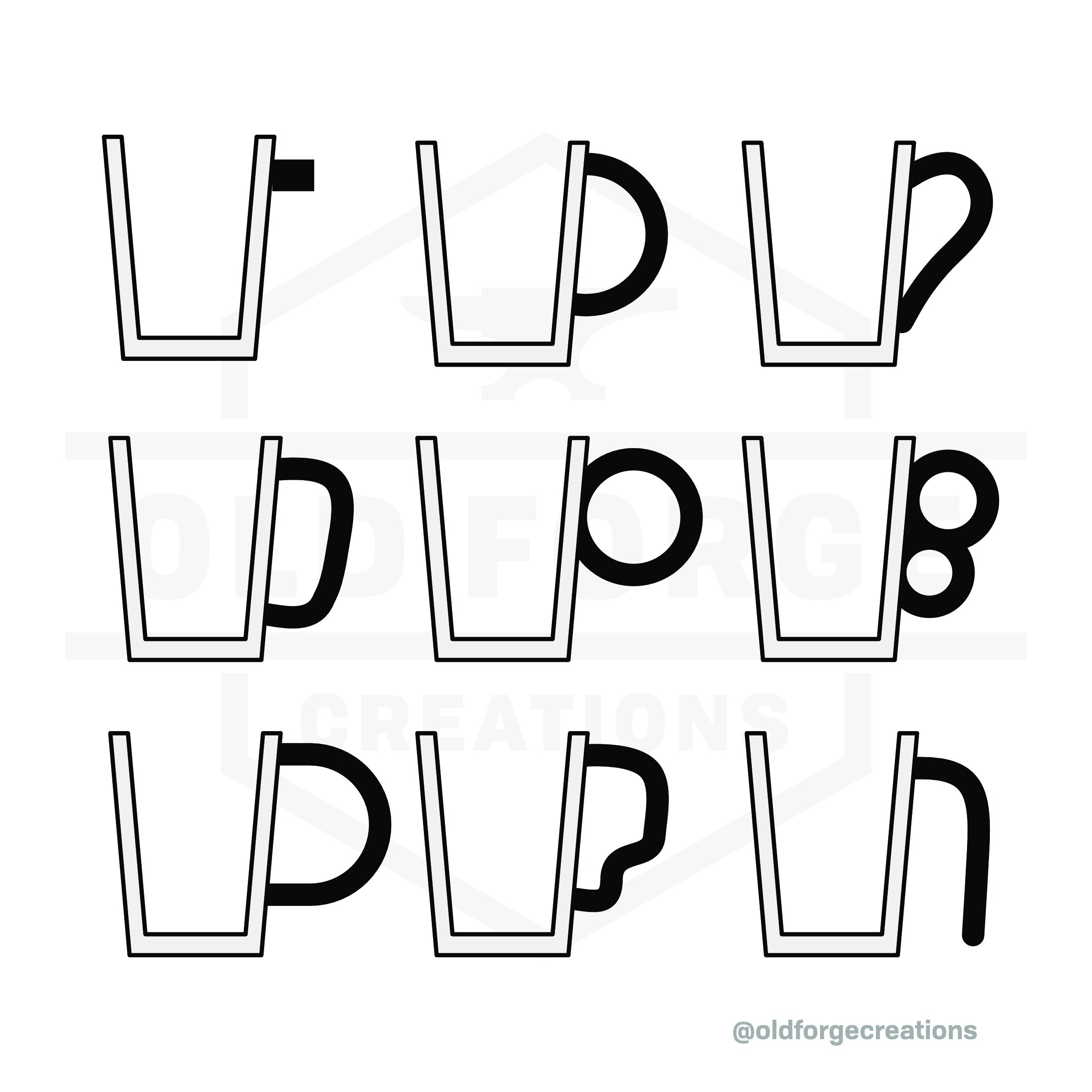Packing And Shipping Pottery
Shipping ceramics is stressful. Stressful on you, stressful on the ceramics, stressful on the planet. Some of this is unavoidable, but a lot of the stress can be lowered by packing well.
Note: My thoughts on this are informed by the work I make, which is generally smaller and relatively durable (mugs, bowls, etc). This might not be true if you make intricate and/or large pieces.
A lot of blame is assigned to malice on the part of the courier when something arrives broken. I don’t believe the majority of the people or machines that handle the package on the journey care one way or the other. Even if they did, the malice would be so diluted by the sheer scale of the number of parcels handled daily that it still doesn’t amount to much. Instead, we’re trying to pack for an indifferent system that is optimised for speed rather than gentleness. A parcel may be dropped, crushed, and generally handled with the minimum amount of care, but within fairly consistent limits. So all we need to do is reach a quality of packing that can withstand that and we can expect all but the most unlucky pieces to survive the journey.
Factors
There are plenty of competing factors when it comes to deciding how to pack anything, but particularly something handmade and expensive.
Protection - The most obvious one. The ceramic item(s) should arrive undamaged, and this will be more likely with some packaging options than others.
Appearance - The aesthetics and quality of packaging can vary greatly, with various different material and colour options as well as the option to customise them (stamped, stickered, printed, etc)
Sustainability - Sustainability and ease of recycling/disposal is a big factor for some consumers, less so for others. This could be from the packaging type (e.g. plastic bubble wrap vs paper) or the material source (e.g. recycled materials, sustainably sourced new materials, or materials that don’t specify).
Cost - Packaging can be expensive, particularly if it’s aesthetic, non-standard, and/or more effort has gone into sustainability. Someone needs to pay the costs and, whether you mentally frame it as the customer or the maker paying the extra cost, decisions about the previous two points will impact this one.
Bulkiness - This is a balance of protection vs sustainability vs cost. Some packaging options are less protective than others, and need more of them in order to adequately protect the piece. This means a larger box is needed, which can mean a higher shipping cost. Fewer parcels on a plane means a higher carbon cost per box.
There are several points on the list that are more or less directly opposed to others. It would be perfect to have beautiful packaging made from recycled and recyclable materials, that only required a small amount to protect items perfectly, and have that for a low cost. That’s not possible. A trade-off needs to be made between some of the points on the list, and it’s up to you to decide which are your priority and which are less important.
Wrapping
The first layer of protection can come from what you wrap around the piece. I would definitely recommend using something protective when sending internationally, as customs will not repack a box the way they found it. An unprotected piece might be very safe in the middle of a box of padding, but the wrapping will at least give it a chance when customs put it back thoughtlessly.
Bubble Wrap
Bubble wrap is the ultimate standard of packaging in my opinion. There are upsides to bubble wrap that might not be obvious until you’ve tried the alternatives, but bubble wrap is amazing at what it does. It is very effective at cushioning impacts because the thin plastic is deformable and elastic, meaning the individual pockets of air can compress to absorb a shock and return to their original shape without significantly compromising the material strength (ideal for repeated impacts or compression). It is very flexible, allowing it to be tightly wrapped around complex shapes and easily stuck into place, without it attempting to return to an original shape (which makes packing with it far easier than some more rigid alternatives). It’s light, seeing as it’s mostly air and it’s fairly cheap.
The downsides are fairly obvious. It is single use plastic. It can be recycled but it’s one of the less commonly accepted plastics (not to mention the whole issue of recycling being shipped to poorer countries rather than dealt with locally, and ending up in the ocean anyway). There are some that use up to 50% recycled plastic, which is an improvement at least. There are also oxo-degradable bubble wraps, which seem like they might be an improvement as they degrade faster naturally, but they likely just speed up the rate at which microplastics end up in the ocean.
RanPak
The next best alternative I’ve found is the RanPak expanding paper packaging. It is a system that provides you with a roll of precut paper and a mechanism to stretch the paper. As it stretches, the cuts expand to form a 3D mesh. This is combined with a tissue layer to build up thickness of compressible padding as it’s wrapped around an object.
It’s a very clever concept, and replicates some of the attributes that make bubble wrap so effective. It also has some unique upsides too. By expanding immediately before use, it takes up a lot less shipping/storage space than prefilled bubble wrap. It’s also easily and universally recycled. It even looks a lot classier than bubble wrap, although I’ve found it a real struggle to make the end look that neat.
Unfortunately, there are downsides. I’ve found that it’s less effective than bubble wrap, meaning you need more of it to adequately protect a piece. As it’s made of paper rather than plastic, its ability to absorb an impact and return to the original shape is more limited, and seems to crush over time. It’s the expanded nature of the shape that provides a crumple zone, but once this has crumpled you’re relying on a couple of mm of paper to protect the ceramics. Using more means more weight and a bigger box. This is particularly true when sending multiple items in the same box, as pieces need to be protected from hitting each other as well as external impacts.
Other
There are other wrapping options too, such as corrugated cardboard, ‘paper bubble wrap’ (which is just card that has a slight 3D texture), and less protective options like tissue or craft paper. In my experience, these tend to be hard to work with and pretty mediocre at protection too.
Overall
There is no universal winning option here. It will partly depend on what you’re sending, the way you pack it, whether you’re sending multiple pieces, the void fill option you use, and the impression you want to create when the item is unboxed.
If you can reuse bubble wrap from things you (or family/friends) have ordered, then that’s the best option in terms of protecting the work and planet, but does shift the responsibility of recycling it to your customers.
My personal compromise (at time of writing) is to use RanPak for orders of a single smaller piece (mugs, tumblers, small bowls, etc), and for orders within the UK. After a higher breakage rate with RanPak for international orders of multiple pieces, I’m sticking with bubble wrap (reused where possible) for these. I believe global warming is a more existential threat than plastic waste, and remaking and reshipping pieces is worse overall, so avoiding breakages is the most important goal of the packaging.
Void Fill
It is possible to use enough wrapping (especially with the RanPak) to fill a box, but you will likely want something else to fill the space between the wrapped piece and the box walls. This will be doing the majority of the cushioning on the journey.
Packing Peanuts
There are two types of packing peanut commonly used. Expanded polystyrene and expanded starch. The starch is a very, very clear winner here. They’re compostable (they’re even edible, but I wouldn’t recommend it!), biodegradable, compressible, cheap, and incredibly effective. They dissolve in water so can be disposed of down the drain (and are just starch, so this isn’t an issue).
The only advantage the polystyrene peanuts have is that they will survive the box getting soaked (FedEx have done this to one of my packages, but it’s not a common issue at least).
Air Pockets
There are systems that inflate various shapes and sizes of plastic pocket. These have a lot of the same upsides and downsides as bubble wrap, with the added upside of not taking up much storage space as they’re inflated before use but the downside of having to buy or rent a machine to inflate them (cheapest on RajaPack is £55 a month). There are newer paper and starch pockets that are 100% biodegradable, which would be a good solution if it wasn’t for the cost of the machine required to inflate them.
If you’re reading this, I expect making your own is not a sensible option for you, but reusing air pockets from things you’ve ordered can be a great way to pack out larger boxes without adding much weight.
Paper
There are a few different paper options for void fill. You can use premade/precut shredded paper options, or get a roll of paper and crumple it to pack into the spaces. I haven’t used any of these options so can’t compare them to the starch packing peanuts, but I’m sure they’d be fine if used correctly.
Overall
The goal with void fill is to take up space with something protective, light, cheap, and easy to dispose of. The starch packing peanuts do such a great job of this that I’ve never needed to look into an alternative.
Boxes
There isn’t a huge amount to say about boxes. They come in myriad sizes and designs, and picking the right one can be a challenge. I have dozens of different sizes so I can match the same to orders of multiple pieces, but the majority of my work is single mugs/tumblers shipped in 9x6x6” (229x152x152mm) double wall boxes.
Double Boxing
Double boxing is exactly as it sounds. Boxing the work, then putting the first box inside another box. This offers slightly more protection as impacts are absorbed by the second box and spread over a larger area. It also allows you to have both an aesthetically pleasing box inside with a cheap but durable double walled outer box. The downside is the extra cost of the second box and potentially requiring a larger outer box (and potentially higher shipping cost).
Tape
There are a few different options for parcel tape, but the main two are self-adhesive plastic and paper rolls. The paper ones work perfectly well, and can be recycled with the box, so I can’t see any need to use the plastic.
You can personalise any part of the packaging, but this is the part I choose to buy with my logo on. My logic is that I have a range of different box shapes, but all of them get sealed with the same tape, so personalised tape is the easiest way to get my branding on everything I send out.
Fragile Stickers
Sometimes you’ll hear people say that couriers take their frustrations out on boxes with FRAGILE stickers. I’m sure this opinion is in part from articles like this where people have tested parcel handling under various conditions, but I’ve never seen anything extensive enough to prove it (that article tested a very limited number of times, so it’s impossible to say if it was an unlucky journey or a consistent pattern). As I said at the start, I don’t believe it. I think most people handling the parcel just won’t have the time, energy, or capacity (if it’s an automated system) to handle things with differing levels of care.
However, what’s more important is the message it sends to the customer. If something is packed well and marked as fragile, it looks like you did all you could. An order arriving broken is frustrating at the best of times, but if it seems like it was as an avoidable result due to lack of care from the sender then it’s significantly more frustrating.
How To Pack
If you’re not happy dropping a parcel on the journey to the post office, then it almost certainly won’t survive the journey after you hand it over. You can more or less guarantee that a box will be dropped and squashed repeatedly on the way to its destination. The good news is that the previously discussed packing materials are more than enough to keep ceramics safe on a journey to the other side of the planet, as long as they’re used correctly.
The two things that will protect a piece are cushioning and distance. You want it surrounded by something capable of absorbing and diffusing an impact, and you want enough distance between it and anything capable of breaking it (outer wall or another piece in the same box) that it’s very unlikely to come into contact even with an extreme impact.
My Process
As I said at the top, this is based on what I send. If your work is different this may not be the best option (or an option at all).
Wrap: I use RanPak where I feel it will be sufficient, and bubble wrap for international orders of multiple pieces. I generally try to include a free gift tumbler with mugs (discussion about free gifts here), and this gets wrapped in tissue and placed inside the mug (with additional padding if needed). This means there’s no additional space required in the box, and the gift is protected with the same protective wrap as the main piece.
I use one sheet of bubble wrap (perforated 500x500mm roll) folded in half for a single mug. This gives the entire mug at least a double layer of bubble wrap. I wrap it tightly and stick it in place.
My process with RanPak is less precise due to the nature of the product and its requirement of constant tension to maintain the 3D shape. You have to pull the paper tight before wrapping to get any thickness (and therefore protection), so it can’t be precut to standard lengths. Instead, I place the mug on the paper layers, pull them tight to expand the protective layer, then wrap and tuck until multiple layers have been built up. I then attempt to stick the end to hold it in place.
Inner Box: If I’m sending a single mug, I will generally double box. This is partly for protection, partly an aesthetic choice, and partly because I know some people buy my mugs as gifts and having that second box makes it easier to wrap later. I use a quick assembly single wall postal box (no tape/glue required) and stamp it with my logo. I don’t generally use inner boxes on order of multiple pieces or on non-mug/tumbler orders, because I haven’t found a way to make it work as effectively. I can use the same size outer box when it’s a single mug, but double boxing multiple pieces usually requires a larger outer box.
Void Fill: I use starch peanuts and pack them in tight. One of the best things about the starch peanuts is that they’re fairly compressible, meaning they can be squashed into a gap and will compress to fill it perfectly. I pack a small amount into the inner box to make sure the piece can’t rattle around in it, then close that up and put it inside the outer box.
Outer Box: I use a generic brown cardboard double wall box for my outer. They’re cheap, made of mostly recycled paper, are 100% recyclable, and do a good job of absorbing impacts. I pick the best size (can be a struggle when packing orders with a disparate selection of pieces), then tape it.
Tape: I use custom printed self-adhesive paper tape. I have my logo and ‘FRAGILE (Handmade Ceramics)’ printed onto it, so it functions as both branding and a fragile warning that might be slightly more likely to stand out than the generic FRAGILE tape (but as previously mentioned, I don’t think this does much either way). The tape can be recycled with the box, making it much easier for the customer to deal responsibly with the packaging.
Void Fill (again): I put a layer of starch peanuts in the bottom of the outer box, put the inner box (or wrapped pieces if it’s an order without the inner box) on this layer and pack peanuts in tightly around them making sure there’s as much distance as possible from anything they might touch on the journey. I repeatedly compress the peanuts into the gaps as I do this.
Business Card: I don’t include much in the way of branded, printed material with my orders. I know some makers like to include a range of things like stickers and postcards, but I don’t generally use these when I receive them so I don’t include them with my orders (they’re surprisingly expensive, it could easily add 1-2£/$ of costs to every order). Instead, I just have an unlaminated business card with my details on one side and the recycling instructions on the reverse. I think this is becoming less important as starch packing peanuts are becoming the default, but instructions on how to dispose of them is still probably a good idea.
Tape (again): I finish sealing the box with more tape, giving it a couple of layers just in case.
Shipping Label: I use self-adhesive thermal paper labels from a label printer (Dymo 4XL, I highly recommend it) which are a plastic free and significantly faster option than using plastic document sleeves. Most/all couriers will have the option to produce label artwork for these printers.
Shipping
I’m not quite sure how to tackle this topic. The choice of courier is a huge decision and will affect the cost and service, but it’s also so situationally specific that I’m not sure I can offer much useful insight. So, what I’ll do here is quickly cover the choices I’ve made and why. Obviously these are taken from my limited and UK specific experience.
I send the vast majority of my orders with Royal Mail. I have a business account with them, and I have free weekday collections from the studio. You can get the free collections if you send 1000 tracked parcels a year (international and domestic) and I can only get close to that number because I have the tools as well as the ceramic pieces.
I really like the service that Royal Mail offer. The pricing is pretty consistent (meaning I can have a standard cost for international orders based on weight, and I don’t get caught out by individual countries having significantly higher delivery costs), the service is consistent, parcels seem to generally be handled well, and the interface works well. I use Click and Drop integrated with Squarespace, so orders are automatically imported. Where I’ve specified the weight and customs details, I can automatically generate the correct shipping and CN22 labels with a couple of clicks per order.
There are a few downsides. The international services aren’t quick. When you have a business account the bill is a total for all orders manifested that day, which makes it harder to know exactly how much you paid for each. Setting up the business account was a clunky process, the help and FAQ is often vague and unhelpful (and directly emailing questions is a slow process), and getting the Tracked 24/48 service added to my account took about 6 months of emailing.
Overall though, they’re my courier of choice.
My other option is FedEx.
I set up a business account with FedEx because they had the cheapest rates for international priority shipping, as well as very reasonable domestic rates for larger parcels. The price has gone up significantly since then, but it’s still reasonable, and the speed of service to the US is impressive (often under 24hrs between collection from me and delivery in the States).
Unfortunately, there are some pretty major issues with using FedEx. You don’t get billed until the parcel is delivered, and the price isn’t finalised until that point. This can lead to being significantly overcharged relative to the estimated price, with no clarity whatsoever about why. Even worse, they have made errors in billing me on multiple occasions, twice taking around £500 from my bank account in error and not returning it for months (with emails to the accounts/billing going unanswered).
Their breakage rate is significantly higher than Royal Mail too.
Despite this, the service is very reasonably priced for the speed. I try to use them as infrequently as possible, but when I need a fast service they’re the best option.
I could write a whole blog post about my Royal Mail setup and considerations, but this post is long enough already and I don’t think that addition will be useful to many people. If you would like me to add it on the end, please let me know though.
Summary
Shipping work is stressful and time consuming.
A little thought about your packaging selection and process can significantly reduce both aspects.
There is no perfect solution, it’s always a trade-off between competing considerations.
If you like this sort of content and want to support the creation of more, I now have a Patreon specifically for it or a page on my website if you just want to make a single donation.


















